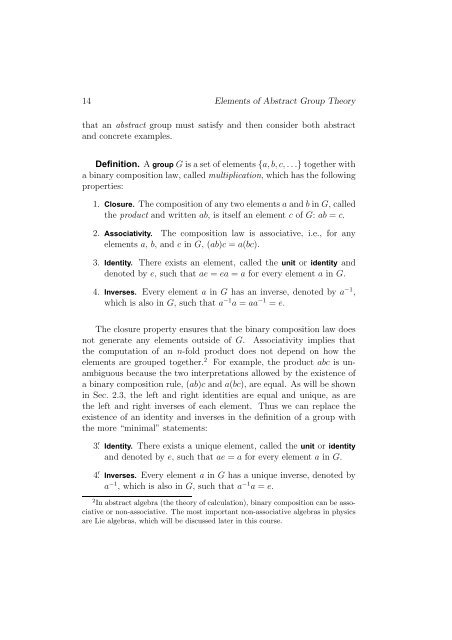Chapter 2 Elements of Abstract Group Theory
Chapter 2 Elements of Abstract Group Theory
Chapter 2 Elements of Abstract Group Theory
Create successful ePaper yourself
Turn your PDF publications into a flip-book with our unique Google optimized e-Paper software.
14 <strong>Elements</strong> <strong>of</strong> <strong>Abstract</strong> <strong>Group</strong> <strong>Theory</strong><br />
that an abstract group must satisfy and then consider both abstract<br />
and concrete examples.<br />
Definition. A group G is a set <strong>of</strong> elements {a,b,c,...} together with<br />
a binary composition law, called multiplication, which has the following<br />
properties:<br />
1. Closure. The composition <strong>of</strong> any two elements a and b in G, called<br />
the product and written ab, is itself an element c <strong>of</strong> G: ab = c.<br />
2. Associativity. The composition law is associative, i.e., for any<br />
elements a, b, and c in G, (ab)c = a(bc).<br />
3. Identity. There exists an element, called the unit or identity and<br />
denoted by e, such that ae = ea = a for every element a in G.<br />
4. Inverses. Every element a in G has an inverse, denoted by a −1 ,<br />
which is also in G, such that a −1 a = aa −1 = e.<br />
The closure property ensures that the binary composition law does<br />
not generate any elements outside <strong>of</strong> G. Associativity implies that<br />
the computation <strong>of</strong> an n-fold product does not depend on how the<br />
elements are grouped together. 2 For example, the product abc is unambiguous<br />
because the two interpretations allowed by the existence <strong>of</strong><br />
a binary composition rule, (ab)c and a(bc), are equal. As will be shown<br />
in Sec. 2.3, the left and right identities are equal and unique, as are<br />
the left and right inverses <strong>of</strong> each element. Thus we can replace the<br />
existence <strong>of</strong> an identity and inverses in the definition <strong>of</strong> a group with<br />
the more “minimal” statements:<br />
3 ′ . Identity. There exists a unique element, called the unit or identity<br />
and denoted by e, such that ae = a for every element a in G.<br />
4 ′ . Inverses. Every element a in G has a unique inverse, denoted by<br />
a −1 , which is also in G, such that a −1 a = e.<br />
2 In abstract algebra (the theory <strong>of</strong> calculation), binary composition can be associative<br />
or non-associative. The most important non-associative algebras in physics<br />
are Lie algebras, which will be discussed later in this course.













